Papers by suharjono suharjono

Biota : Jurnal Ilmiah Ilmu-Ilmu Hayati, 2019
The main objective of this research was to calculate the carrying capacity and growth rate ofisol... more The main objective of this research was to calculate the carrying capacity and growth rate ofisolated Microcystis result in Sutami reservoir on a variety of nitrate and phosphateconcentrations in the B-12 selective medium. Research was conducted in the laboratory withpure experiments using completely randomized factorial design with factors of nitrateconcentration variation (8, 16, 32, and 64 ppm) and phosphate (0.2, 0.4, 0.8 and 1.6 ppm) in B-12medium. Repetition of the study was conducted three times at the same time. Microcystispopulation abundance which was counted every day until the stationary phase (day +30) wasused to calculate the rate of growth (β) and maximum abundance of Microcystis can besupported by each medium treatment (γ). The results showed that the growth rate of Microcystiswas not significantly influenced by levels of phosphate in the medium but significantly positivelycorrelated with increasing nitrate concentration in the medium. Carrying capacity or themaximum...

Biodiversitas Journal of Biological Diversity, 2020
Peanut stripe virus (PStV) is a single-stranded positive-sense RNA virus capable of infecting pea... more Peanut stripe virus (PStV) is a single-stranded positive-sense RNA virus capable of infecting peanut plants. An isolate of PStV (PStV-Bm) was collected from a peanut field in the Bima District, West Nusa Tenggara Province, Indonesia and the coat protein (CP) gene of this virus (CP-PStV) was extracted from the viral RNA and analyzed using reverse transcription-polymerase chain reaction methods. The CP-PStV gene of PStV-Bm was aligned with several PStV genes deposited in the Genbank (http://www.ncbi.nml.nih.gov). Based on the nucleotide sequence of the CP gene, PStV-Bm was grouped into a similar cluster with other PStVs that originated from Indonesia with a similar index, ranging from 96.8% to 98.9%. Genetic similarity (about 96.1%) was also observed between PStV-Bm and PStV from the USA. This genetic similarity indicated that viruses from adjacent regions have high genetic relationships. Some amino acid differences were observed in PStV-Bm that may be typical of this strain.
Journal of Tropical Life Science, 2013
Journal of Tropical Life Science, 2013

International Journal of Microbiology, 2015
Malaria is endemic to Lombok Island, Indonesia. One approach to suppress malaria spread is to eli... more Malaria is endemic to Lombok Island, Indonesia. One approach to suppress malaria spread is to eliminate anopheline larvae in their habitat and the environmentally safe agent is bacteria, that is,Bacillus sphaericus. However, there is no information regarding local isolate ofB. sphaericusthat is toxic to mosquito larvae from Lombok. The aims of the study were to isolateB. sphaericusfrom soil in areas close to beach surrounding Lombok Island and to test their toxicity against 3rd instarAnopheles aconituslarvae. Soil samples were collected from 20 different sampling locations from Lombok Island and homogenized with sterile physiological salt solution. Suspension was heat-shocked at 80°C for 30 minutes and then spread onto antibiotic-supplemented NYSM solid medium. Colonies grown were characterized and subjected to initial toxicity test against anopheline larvae. Isolates with more than 50% killing percentage were subjected to bioassay testing against anopheline larvae. From 20 location...
Asian Pacific Journal of Tropical Biomedicine, 2013

ABSTRAK Salah satu kegagalan dalam budidaya tanaman tomat disebabkan oleh penyakit layu Fusarium ... more ABSTRAK Salah satu kegagalan dalam budidaya tanaman tomat disebabkan oleh penyakit layu Fusarium . Penyakit ini dapat diatasi dengan penggunaan kapang antagonis yang mampu menghambat pertumbuhan kapang patogen. Tujuan penelitian ini adalah untuk mengisolasi Fusarium patogen dan kapang antagonis, serta mengetahui potensi kapang antagonis untuk menghambat pertumbuhan Fusarium patogen. Tahapan penelitian meliputi isolasi Fusarium patogen dan kapang antagonis, skrining kandidat kapang antagonis, dan uji antagonis dengan metode dual-culture . Data dianalisis ragam satu arah dengan α = 0,05. Dua isolat Fusarium patogen diperoleh dari batang tanaman tomat dan 19 kandidat kapang antagonis berasal dari sampel tanah. Kapang tanah yang berpotensi untuk menghambat pertumbuhan Fusarium yaitu KT.7, KT.10. dan KT.16. Isolat KT.16 menunjukkan penghambatan tertinggi terhadap isolat FB.1, sedangkan isolat KT.7 menunjukkan penghambatan tertinggi terhadap isolat FB.2, yaitu berturut-turut 59,84 % dan ...
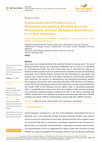
KnE Life Sciences, Jun 7, 2022
Clove plants are routinely fertilized with synthetic fertilizer to increase yield. The use of syn... more Clove plants are routinely fertilized with synthetic fertilizer to increase yield. The use of synthetic fertilizer reduces soil productivity. Biofertilizer can be used as an alternative for increasing soil fertility. The goal of this study was to determine the potency of bacteria isolates capable of producing indole acetic acid (IAA) hormone and solubilizing phosphate, and to identify bacteria species from the rhizosphere of clove plants. Soil samples were collected from the clove plants' rhizosphere, environmental parameters were measured, the potency of IAA-producing and phosphate-solubilizing bacteria was analyzed, and bacteria were molecularly identified. After 48 hours of incubation, isolate TCKI 5 from Karangasem produced the highest IAA hormone levels (19.64 ppm), and isolate TCBP 6 from Buleleng had the highest index of solubilizing phosphate (1.91). A compatibility test between the three best isolates of IAA hormone-producing and phosphate-solubilizing bacteria revealed that TCKI 5 was able to associate with TCBP 6. Isolate TCKI 5 was identified as Leclercia adecarboxylata C107 with a 99.92% similarity, and isolate TCBP 6 as Burkholderia cepacia GJ8 with a 99.61% similarity.

Biotropika: Journal of Tropical Biology, Jun 19, 2015
Tanaman cengkeh (Syzygium aromaticum L.) merupakan salah satu komoditi perkebunan yang memiliki p... more Tanaman cengkeh (Syzygium aromaticum L.) merupakan salah satu komoditi perkebunan yang memiliki peranan penting bagi pendapatan devisa negara. Perkebunan cengkeh rutin mengunakan pupuk kimia sintetik dalam proses pertumbuhannya. Permintaan produk pertanian dan perkebunan yang bebas akan bahan kimia semakin meningkat. Tujuan dari penelitian ini adalah mempelajari potensi isolat bakteri penghasil hormon IAA dari tanah rhizosfer tanaman cengkeh. Tahapan penelitian meliputi pengambilan sampel tanah, isolasi bakteri penghasil hormon IAA dan analisa hormon IAA. Bakteri yang berpotensi menghasilkan hormon IAA tertinggi adalah isolat TCKI 5 (32,84 ppm) dari Karangasem. Hasil tertinggi ini didapatkan pada waktu inkubasi 48 jam. Berdasarkan nilai OD terlihat bahwa isolat TCKI 5 pada waktu inkubasi 48 dan 72 jam memiliki nilai OD yang sama yang merupakan fase stasioner Kata kunci: bakteri, tanaman cengkeh, Indole Acetic Acid (IAA), rhizosfer ABSTRACT Cloves (Syzygium aromaticum L.) is one of the plantation commodities which have an important role for the country's foreign exchange earnings. The clove plantation, was routine use of synthetic fertilizer. The demand of agricultural and plantation product free of chemicals has increased. Synthetic fertilizer has negative impact on soil productivity The purpose of this research is studied the potencyl of bacteria isolate to produce IAA hormone from rhizosphere of clove plant. The research includes collecting sample of rhizosphere soil of clove plant, isolation and analysis the potency of bacteria IAA hormone producing. Isolate TCKI 5 from Karangasem has highest IAA hormone producing (32,84 ppm) in 48 hours incubation. Based on the OD seen TCKI 5 produce IAA hormone of stationer phase
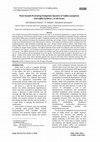
The Journal of Experimental Life Sciences
Plant Growth Promoting (PGP) Endophytic bacteria are used as an alternative biofertilizer to supp... more Plant Growth Promoting (PGP) Endophytic bacteria are used as an alternative biofertilizer to support soil health and plant productivity. This research aimed to isolate, analyze the potential, and identify the endophytic bacteria of Robusta and Arabica coffee plants as biofertilizer agents. Endophytic bacteria were isolated from the roots of coffee plants and tested for their potential to produce IAA, phosphate-solubilizing, and nitrogen fixation. Potential endophytic bacterial isolates were identified based on 16S rDNA sequence similarity. Total isolates from Robusta coffee consisting of ten IAAproducing bacteria, eight phosphate-solubilizing, and seven nitrogen fixation bacteria isolates. Total isolates from Arabica coffee roots were 12 isolates of IAA-producing bacteria, seven isolates of phosphate-solubilizing bacteria, and six isolates of nitrogen fixation bacteria. The highest potential of the isolate from Robusta roots was SS.E2 isolate to produce IAA 110.73 μg.mL-1 ; SS.P3 isolate to dissolve phosphate 4.42 μg.mL-1 , and SS.N2 isolate to produce ammonium 3.15 μg.mL-1. The highest potential of the isolate from Arabica roots was SW.E9 isolate to produce IAA up to 257.16 μg.mL-1 ; SW.P5 isolate to dissolve phosphate up to 4,55 μg.mL-1 ; and SW.N6 isolate to produce ammonium up to 1.16 μg.mL-1. Isolates SS.E2, SW.E9, SS.P3, SW.P5, SS.N2, and SW.N6 were respectively identified as Bacillus cereus ATCC 14579, Bacillus cereus ATCC 14579, Rahnella aquatilis B35, Kluyvera intermedia TPY16, Rahnella aquatilis B35, and Pseudomonas tolaasii NCPPB 2192. Potential PGP isolates can be developed as biofertilizer agents for the coffee plant.
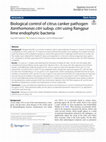
Egyptian Journal of Biological Pest Control
Background Rangpur lime (RL) is a common rootstock cultivar used worldwide. However, it is known ... more Background Rangpur lime (RL) is a common rootstock cultivar used worldwide. However, it is known to have a high susceptibility to citrus canker (CC). To meet the increasing demand for healthy citrus seedlings, this research aimed to study the potency of RL endophytic bacteria as a biocontrol agent of the CC pathogen Xanthomonas citri subsp. citri. The isolates were collected from healthy RL leaves and subjected to in vitro and in planta antagonistic tests against XCC, alongside its cell-free supernatant (CFS). Potential isolates were identified according to their 16S rDNA sequence similarities. Results As many as 21 isolates were obtained from the leaves of healthy RL trees. Two (B1 and C8) isolates demonstrated promising inhibitory activity against XCC. Based on the in vitro assays, the cell suspensions (CS) of these isolates could effectively inhibit the growth of XCC, with an optimum clear zone diameter of 8.41 and 7.51 mm, respectively. Consistent with CS, their CFSs also displa...
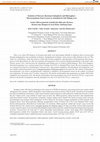
Jurnal Agronomi Indonesia (Indonesian Journal of Agronomy), 2021
There were about 900 hotspots of artisanal and small scale gold mining (ASGM) in Indonesia that r... more There were about 900 hotspots of artisanal and small scale gold mining (ASGM) in Indonesia that recovered gold through amalgamation and cyanidation techniques. Amalgamation technique causes mercury (Hg) pollution to the soil. This study was a preliminary study that aimed to isolate Hg-resistant endophytic and rhizosphere microorganisms from pioneer grasses in the Hg-polluted soil. The most potential microorganism will be used for Hg phytoremediation in the future study. Pioneer grasses were collected from the abandoned gold mining area in Central Lombok Regency, West Nusa Tenggara. Total microorganisms were counted using Colony Forming Unit (CFU) or Standard Plate Count. The microorganism colony was characterized based on morphological characteristics. Hg-resistant endophytic and rhizosphere microorganisms were successfully isolated from pioneer grass (Cynodon dactylon and Eleusine indica) in the study site. The colonies of rhizosphere microorganisms were diverse morphologically com...
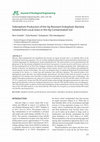
Journal of Ecological Engineering, 2021
Mercury (Hg)-contaminated soil remediation has become an urgent necessity due to its harmful effe... more Mercury (Hg)-contaminated soil remediation has become an urgent necessity due to its harmful effect on the environment and living organisms. The use of plant-endophyte partnership for phytoremediation demonstrates an excellent opportunity for cleaning heavy metal contaminated soil. This study aimed to screen and characterize the phenotype of the Hg-resistant endophytic bacteria from local grasses (Cynodon dactylon and Eleusine indica) in the Hg-contaminated soil of West Nusa Tenggara, Indonesia with siderophore-producing traits. Siderophore production of bacteria was qualitatively tested using overlay-chrome azurol S (O-CAS) medium and quantitatively tested using the succinic acid medium. The assay was designed using a Completely Randomized Factorial Design consisting of two factors, i.e., isolate type and incubation time with three replicates. The selected isolates were pathogenicity tested, then they were phenotypically characterized. All tested isolates showed a positive result on changing O-CAS medium color from blue to yellow/brown that indicated hydroxamate type of siderophore. The highest siderophore production was achieved at 72 hours of incubation, by the EI5 and EI6 isolates (62.90% and 35.31%, respectively). In turn, the CD6, EI5 and EI6 isolates achieved high siderophore production at a short incubation period (48 hours). However, during the hemolysis test, only the CD6 and EI6 isolates were not pathogenic. The CD6 and EI6 isolates would be used for phytoremediation on Hg-contaminated soil in the future study. On the basis of the 16S rDNA analysis, it was shown that the CD6 isolate was Jeotgalicoccus huakuii and the EI6 isolate was Bacillus amyloliquefaciens.
The aim of this research is to conduct phylogenetic analyzes of Phanerochaete chrysosporium ITB i... more The aim of this research is to conduct phylogenetic analyzes of Phanerochaete chrysosporium ITB isolate using DNA sequences of the internal transcribed spacer (ITS) region. The rDNA ITS sequence was developed by using universal ITS5/ITS4 primer pairs. The results showed that the DNA sequence of the ITS region of 700 bp length of Phanerochaete chrysosporium ITB has the highest similarity of 99.6% with PhanerochaetechrysosporiumBKM-F-1767, RP78, PV1, KCTC 6728, SF-4, ATCC MYA- 476, FCL208, FCL236, and Gold-9-419-4. Phanerochaete chrysosporium ITB isolate suspected as new strain of Phanerochaete chrysosporium. Keyword: Phanerochaete chrysosporium, ITS, phylogenetic.
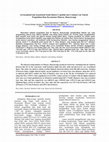
The fish processing industry in Muncar, Banyuwangi, produced wastewater containing fish oil. Lipo... more The fish processing industry in Muncar, Banyuwangi, produced wastewater containing fish oil. Lipolytic bacteria that live in the wastewater could hydrolyze lipids into fatty acids and glycerol by way of produced lipase. This study was aimed to obtain excellent lipolytic bacterial isolates from fish mill wastewater. Isolation of bacteria using a simple mineral media, enzyme qualitative test based clear zone diameter using olive oil 5% as substrate plus 0,01% methyl red. Data of diameter clear zone on the 7th day of incubation were analyzed using One-Way ANOVA with a significance level of 95%. Lipase activity of 4 isolates with the highest diameter clear zone were tested quantitatively by titrimetric method using 0.03 N NaOH. Diameter clear zone of isolates 1me, 3ma, 3mb, and 3mc respectively was 4,08±0.21 mm; 3,94±0.03 mm; 3,99±3.15 mm; and 4.02±0.15 mm. Optimum lipase activity of isolates 1me, 3ma, 3mb, and 3mc respectively was 3,52 U/ml (24 hours); 3,98 U/ml (20 hours); 3,74 U/ml (...

Biodiversitas Journal of Biological Diversity, 2020
Endophytic bacteria tolerant of chromium have the potential to reduce Cr (VI) to Cr (III) and pro... more Endophytic bacteria tolerant of chromium have the potential to reduce Cr (VI) to Cr (III) and produce compounds that can improve plant survival in Cr (VI) contaminated soils. This study was performed to isolate and identify Cr (VI)-tolerant bacteria from the endosphere of Ficus septica Burm.F growing on the tannery waste contaminated soil, Screening of bacteria was carried out based on the level of Cr (VI) tolerance. High tolerant isolates were tested for their potential of Indole Acetic Acid (IAA) and exopolysaccharide (EPS) production, phosphate solubilizing, and the presence of chromate reductase (ChR) genes. The most potential bacterial isolate was identified based on 16S rDNA sequences. The results showed that three isolates (E3, E4, and E8) were tolerant of Cr (VI) up to 900 mg/L. E8 isolates produced the highest IAA production (20.05 μg/mL), phosphate solubilization (127.78 μg/mL), and EPS production (9,70 μg/mL), and all isolates had the ChR gene. E8 isolate was found to be 100% identical to Enterobacter cloacae ATCC 13047.
ZOOTEC, 2020
NUTRITION CHARACTERISTICS OF BUFFALO MILK FROM TORAJA, MAKASSAR. The study was conducted to analy... more NUTRITION CHARACTERISTICS OF BUFFALO MILK FROM TORAJA, MAKASSAR. The study was conducted to analyze the nutritional content of milk in Toraja Belang Buffalo. The research method took samples of Toraja Belang buffalo milk in Toraja Regency, South Sulawesi. Sample was put at the cool box before analyzing its nutritional content. The nutrient content of the milk sample was analyzed using a Lacto scan analyzer to see water content, ash content, protein, fat, lactose and BKTL. The results showed that nutritional content of Belang Toraja buffalo milk consisted of protein (3.17%), fat (12.97%), lactose (4.37%), water content (79.49%), ash content (0.88 %) and SNF / BKTL (8.42%).

Biodiversitas Journal of Biological Diversity, 2019
Main energy source commonly used by the community comes from fossil energy, especially petroleum.... more Main energy source commonly used by the community comes from fossil energy, especially petroleum. The crisis of energy showed that Indonesia's fossil energy reserves are limited. Based on this fact it is important to develop alternative energy that environmentally friendly and sustain, especially bioethanol. The objective of this research was to diversity and potency of indigenous yeast from palm juice of Arenga pinnata Merr., Cocos nucifera L., Nypa fruticans Wurmb., and Borassus flabellifer L. for bioethanol production. Yeast from juice of the four species of palm was isolated using Yeast Malt Extract Agar (YMEA). Those isolates were screen base on ethanol production in coconut water media. The potential of yeast isolates was identified base on 18S DNA sequence similarity. The four potential isolates of yeast were A3A from A. pinnata, K1A from C. nucifera,

Advances in Microbiology, 2015
Shrimp waste contains 20%-60% chitin and possible to be source of chitinolytic bacteria. Chitinol... more Shrimp waste contains 20%-60% chitin and possible to be source of chitinolytic bacteria. Chitinolytic bacteria are capable of hydrolyzing of chitin progressively to produce N-acetylglucosamine monomer which can be used to overcome the shrimp waste. The objectives of this research were to identify species of bacteria with high activity of chitin degradation in shrimp waste and to analyze their potency as chitin degradation agent. The research consists of screening of chitinolytic bacteria based on chitinolytic index, activity assay of chitinase using colorimetric method, and molecular identification of bacteria based on 16S rDNA sequences. Two of eighteen isolates of chitinolytic bacteria (PBK 2 and SA 1.2 isolates) showed the highest chitinolytic index, which were 2.069 and 2.084, whereas chitinase activity was 0.213 and 0.219 U/ml respectively. Based on 16S rDNA sequences, isolate of PBK 2 was identified as Acinetobacter johnsonii 3-1, whereas SA 1.2 was identified as Bacillus amyloliquefaciens GR53 with 99.78% similarity.
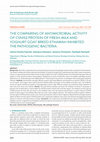
Materia Socio Medica, 2016
Background: Goat milk is reported to have antimicrobial activity of several pathogen bacteria tha... more Background: Goat milk is reported to have antimicrobial activity of several pathogen bacteria that contained on food materials. The research related with antimicrobial activity of Alpha-S2 casein from goat milk is relatively less than other casein components. Herein, we reported the antimicrobial activity of caprine Alpha-S2 Casein (CSN1S2) protein from Ethawah breed goat milk and yoghurt in Gram positive (Listeria monocytogenes, Staphylococcus aureus and Bacillus cereus) and negative pathogen bacteria (Escherichia coli, Salmonella typhi and Shigella flexneri). Those bacteria were known as pathogens that caused gastrointestinal infection. Methods: Serial dilution and agar diffusion analysis with three different concentrations of caprine CSN1S2, 1.25 mg/ ml, 2.5 mg/ml, and 5 mg/ml were used to test the inhibition effect of protein on the viability of bacteria cells. The inhibitory activity of caprine CSN1S2 was based on dose dependent manner. Agar diffusion analysis was showed the larger diameter of clear zone at B. cereus and S. flexneri. Results: The serial dilution analysis was shown the inhibition of almost in all groups of bacteria with concentration 5 mg/ml higher by CSN1S2 protein of goat fresh milk than yogurt. The inhibitory activity caprine CSN1S2 protein of fresh milk was shown a vary inhibition clear zone with optimal concentration 5 mg/ml, however CSN1S2 protein of goat yogurt intermediate effectively was only in gram negative bacteria. The weakness bacteria against inhibition activity caprine CSN1S2 protein was B. cereus (Gram positive) and S. flexneri (Gram negative). Meanwhile the strongest bacteria against inhibition activity caprine CSN1S2 protein was S. typhi (Gram negative), may cause in this bacteria has lipopolysaccharide prevent to interact with that protein as proper. Conclusion: This study result concluded that the caprine CSN1S2 protein has inhibition activity in opposition to pathogenic bacteria by optimal concentration 5 mg/ml in all bacteria and indicated caprine CSN1S2 protein as anti-microbial agent.

Uploads
Papers by suharjono suharjono